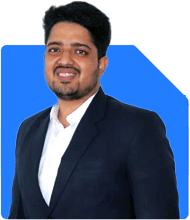44-Year-Old Dad Seeks Investment Advice for Children's Higher Education SIP
Ramalingam Kalirajan |10881 Answers |Ask -Follow
Mutual Funds, Financial Planning Expert - Answered on Jan 05, 2025
He has an MBA in finance from the University of Madras and is a certified financial planner.
He is the director and chief financial planner at Holistic Investment, a Chennai-based firm that offers financial planning and wealth management advice.... more

Hello Sir, I am 44 years old man. I want to start SIP for my children, 6.5 years old daughter and 2.5 years old son. The objective is to secure their future and the funds can be used when they want to go for graduation/higher studies. I have shortlisted the following funds, please let me know if you recommend any changes. Thank you! 1-UTI Nifty50 Index Direct: Rs.2000 2-ICICI Prudential Nifty Next 50 Index Fund: Rs.2000 3-Canara Robeco Bluechip Equity Fund: Rs.2000 4-ICICI Prudential Value Discovery Fund: Rs.3000 5-Parag Parikh Flexi Cap Fund: Rs.2000 6-ICICI Prudential Equity & Debt Fund: Rs.3000 7-Quant Active Find: Rs.3000 8-SBI Contra Fund: Rs.3000 9-Nippon India small cap fund: Rs.3000 10-Nippon India ETF Gold BeES: Rs.2000
Evaluating Your Portfolio
1. Too Many Funds
You have selected 10 funds, which might lead to over-diversification.
Over-diversification can dilute returns and make tracking difficult.
2. Balanced Allocation Missing
There’s a heavy tilt towards equity with insufficient diversification across asset classes.
Adding a debt component can provide stability and reduce volatility.
3. Index Funds
UTI Nifty50 Index Fund and ICICI Prudential Nifty Next 50 Index Fund:
Index funds lack flexibility and cannot outperform during bear markets.
Actively managed funds might be better for your long-term goals.
4. Mid-Cap and Small-Cap Exposure
Nippon India Small Cap Fund:
High risk but high return potential.
Retain for diversification but limit exposure to 10%-15% of your total investments.
5. Thematic and Contra Funds
SBI Contra Fund and Quant Active Fund:
Thematic and contra funds have niche strategies, making them riskier.
Retain only one if aligned with your risk appetite.
6. Gold ETF
Nippon India ETF Gold BeES:
Adds diversification and inflation protection.
However, limit allocation to 5%-10% of your portfolio.
Recommended Portfolio for Your Goals
1. Core Equity Allocation (60%-70%)
Focus on funds that provide long-term stability and growth.
Large-Cap Funds: Replace index funds with actively managed large-cap funds for better returns.
Flexi-Cap Funds: Retain Parag Parikh Flexi Cap Fund for its global diversification and balanced approach.
Mid-Cap and Small-Cap Funds: Retain one small-cap fund (Nippon India Small Cap Fund) for growth potential.
2. Hybrid Funds (20%-25%)
Include hybrid funds to balance equity and debt.
Retain ICICI Prudential Equity & Debt Fund for stability and moderate returns.
3. Gold (5%-10%)
Continue investing in Nippon India ETF Gold BeES for diversification.
Proposed Allocation
To streamline your portfolio, allocate investments more strategically:
Large-Cap Equity Fund: Invest Rs. 4,000 monthly in a strong actively managed large-cap fund like Canara Robeco Bluechip Equity Fund. Large-cap funds provide stability and consistent growth for long-term goals.
Flexi-Cap Fund: Continue investing Rs. 4,000 monthly in Parag Parikh Flexi Cap Fund. This fund offers global diversification and a balanced approach to equity exposure.
Small-Cap Fund: Retain Nippon India Small Cap Fund and allocate Rs. 3,000 monthly. Small-cap funds add high-growth potential but keep the exposure minimal to manage risk.
Hybrid Fund: Allocate Rs. 5,000 monthly to ICICI Prudential Equity & Debt Fund. This hybrid fund balances equity and debt exposure, providing stability with moderate growth.
Gold ETF: Continue Rs. 2,000 monthly in Nippon India ETF Gold BeES. Gold adds a hedge against inflation and enhances portfolio diversification.
Additional Recommendations
1. Debt Component for Stability
Consider short-term debt funds or liquid funds for low-risk capital appreciation.
These can be used for nearer-term educational needs like school fees.
2. Gradual SIP Increases
Increase SIPs by 10%-15% annually as your income grows.
This ensures your investments grow in tandem with inflation.
3. Portfolio Review and Rebalancing
Review your portfolio annually to evaluate performance.
Rebalance if any fund consistently underperforms for over 2-3 years.
4. Tax Planning
Retain an ELSS tax-saving fund to maximise tax benefits under Section 80C.
Final Insights
Your disciplined approach to securing your children's education is commendable. This revised portfolio offers a balanced mix of growth and stability. It ensures you can meet future education milestones confidently. Stay consistent, increase contributions periodically, and monitor performance regularly.
Best Regards,
K. Ramalingam, MBA, CFP,
Chief Financial Planner,
www.holisticinvestment.in
https://www.youtube.com/@HolisticInvestment
You may like to see similar questions and answers below
Nikunj Saraf | Answer |Ask -Follow
Mutual Funds Expert - Answered on Feb 04, 2023
Ramalingam Kalirajan |10881 Answers |Ask -Follow
Mutual Funds, Financial Planning Expert - Answered on Apr 30, 2024
Ramalingam Kalirajan |10881 Answers |Ask -Follow
Mutual Funds, Financial Planning Expert - Answered on Jul 12, 2024
Dr Dipankar Dutta |1841 Answers |Ask -Follow
Tech Careers and Skill Development Expert - Answered on Dec 14, 2025
Nayagam P P |10854 Answers |Ask -Follow
Career Counsellor - Answered on Dec 14, 2025
Radheshyam Zanwar |6744 Answers |Ask -Follow
MHT-CET, IIT-JEE, NEET-UG Expert - Answered on Dec 14, 2025
Radheshyam Zanwar |6744 Answers |Ask -Follow
MHT-CET, IIT-JEE, NEET-UG Expert - Answered on Dec 14, 2025
Dr Dipankar Dutta |1841 Answers |Ask -Follow
Tech Careers and Skill Development Expert - Answered on Dec 14, 2025
Dr Dipankar Dutta |1841 Answers |Ask -Follow
Tech Careers and Skill Development Expert - Answered on Dec 13, 2025
Dr Dipankar Dutta |1841 Answers |Ask -Follow
Tech Careers and Skill Development Expert - Answered on Dec 13, 2025
Mayank Chandel |2575 Answers |Ask -Follow
IIT-JEE, NEET-UG, SAT, CLAT, CA, CS Exam Expert - Answered on Dec 13, 2025
Radheshyam Zanwar |6744 Answers |Ask -Follow
MHT-CET, IIT-JEE, NEET-UG Expert - Answered on Dec 13, 2025
Mayank Chandel |2575 Answers |Ask -Follow
IIT-JEE, NEET-UG, SAT, CLAT, CA, CS Exam Expert - Answered on Dec 13, 2025






















